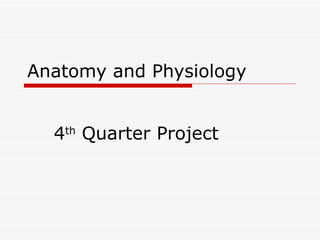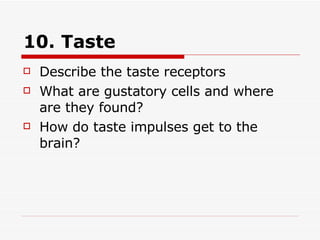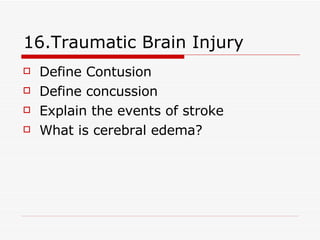Anatomy And Physiology 4th Quarter
- 1. Anatomy and Physiology 4 th Quarter Project
- 2. You will create a short PowerPoint presentation on your assigned topic You will need to teach the class the information that I have directed you to teach. You will e-mail me your PowerPoint by midnight, May 5. You should limit the information per screen; do not use font smaller than 32. Pictures are great.
- 3. Your presentation should be content rich, but stick to the main points. We will have a quiz on all of the presentations.
- 4. 1. Conjunctivitis Describe the conjunctiva What is conjunctivitis? How is it treated? Why is it a concern among school students?
- 5. 2. Internal Anatomy of the Eye Describe the structure and function of the following features of the eye: Sclera Cornea Choroid Ciliary body Iris Pupil retina
- 6. 3. Vision Explain the role of rods and cones in vision Define bipolar cells Ganglion cells Optic nerve Optic disc Fovea centralis Where is the visual center in the brain?
- 7. 4. Path of light through the Eye What is the role of the cornea in vision? Define accommodation Explain how the image is projected on the retina and how the perception is corrected in the brain Explain the difference between myopia and hyperopia How do glasses correct for these distortions?
- 8. 5. Cataracts and Glaucoma What are cataracts? How are they treated? What is glaucoma? How is it treated?
- 9. 6. Structures of the Ear Explain the organs of the outer ear, the middle ear and the inner ear Explain how sound is transmitted through the ear to cochlear duct
- 10. 7. Equilibrium and Strabismus Define the vestibular apparatus Explain “static equilibrium” versus dynamic equilibrium.”
- 11. 8. Mechanism of hearing Where are the hearing receptors found? What is the role of the basilar membrane? How does the impulse get to the brain?
- 12. 9. Smell Receptors and sense of smell Where are the olfactory receptors? How do olfactory receptor cells work? How does the impulse get to the brain?
- 13. 10. Taste Describe the taste receptors What are gustatory cells and where are they found? How do taste impulses get to the brain?
- 14. 11. Gross Anatomy of the Brain Describe the: Cerebral hemispheres Cerebellum Brainstem Diencephalon
- 15. 12. Meninges and Cerebrospinal fluid Describe the 3 different meninges What is cerebrospinal fluid made of and what is its function? What is meningitis?
- 16. 13. White matter, gray matter and Basal nuclei What is white matter and where is it found? What is gray matter and where is it found? What is the corpus callosum and why is it important?
- 17. 14. Alzheimer’s Disease Describe the early symptoms of Alzheimer's Disease Describe the later symptoms of Alzheimer's Disease What happens to the brain of Alzheimer’s patients? Provide some statistics of how many people are afflicted with AD
- 18. 15. Parkinson’s Disease Describe the symptoms of Parkinson's Disease Describe the changes in the brain that take place in the brain of patients with PD Describe treatment of PD
- 19. 16.Traumatic Brain Injury Define Contusion Define concussion Explain the events of stroke What is cerebral edema?
- 20. 17.The Blood Brain Barrier What is the function of the blood-brain barrier? What can pass the barrier? What substances are not permeable to the barrier?
- 21. Rubric 10 points Information reflects research beyond text 40 points Prescribed Questions Clearly Addressed 10 points Presentation to class 20 points şÝşÝߣs communicate without excess verbiage —font large enough 20 points Ppt submitted on time




















